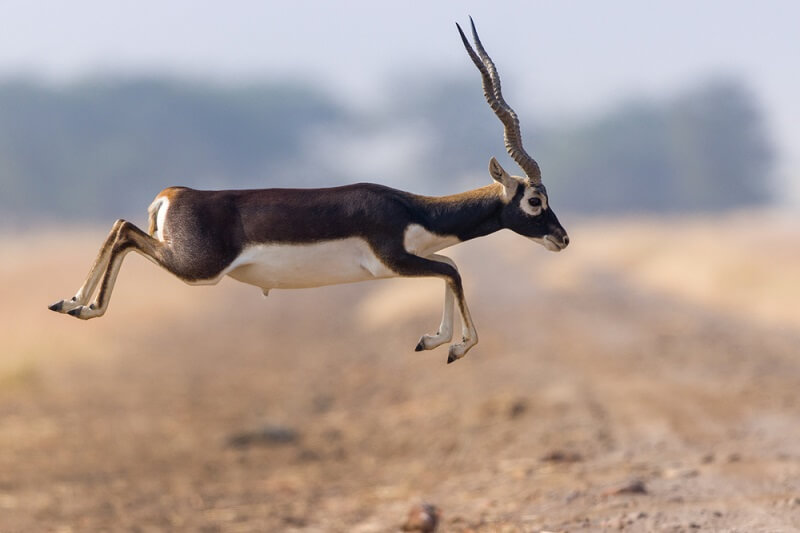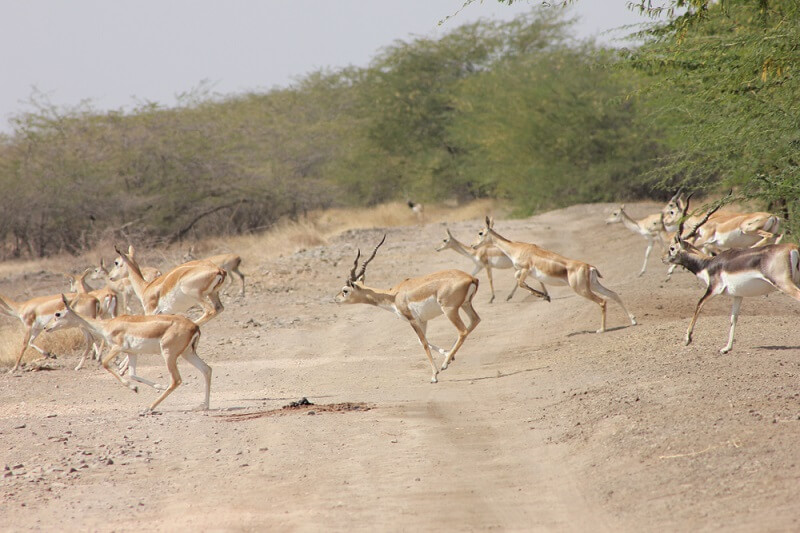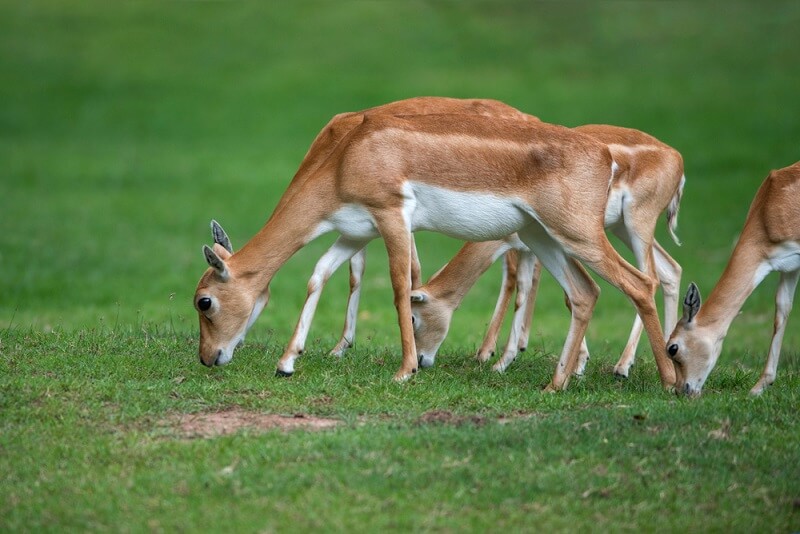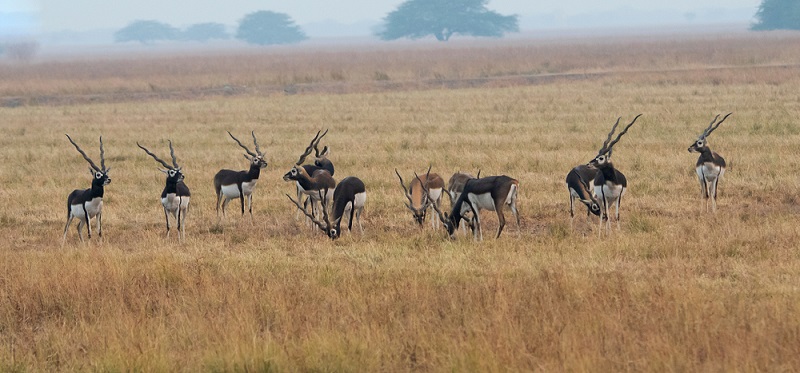
Blackbucks are a species of antelope native to India, Pakistan, and Nepal that have very distinctive corkscrew-shaped horns. The horns – which form a large “V-shape” – are used by males to spar with other males and defend their territory. Like other antelope, blackbucks are grazers that prefer grasslands and can run at very high speeds. Within India, herds of blackbucks were dramatically decreasing through much of the 1900s. Herds of hundreds of thousands were reduced to as few as 50,000 blackbucks across India. While blackbucks are endangered and protected in their native homeland, herds of over 35,000 newly-introduced blackbuck antelope roam freely around Texas. Blackbucks tend to stay in small herds, with males defending small territories to attract females. This “lekking” – as it is known – requires males to constantly be on the defensive during mating season. When a young male with no territory wanders into the territory of an older male, the fight is on! The two males will viciously attack each other, slamming their horns into their opponent and brandishing the sharp tips like a saber. This display can happen for minutes or hours until one of the combatants finally throws in the towel. These antelope serve as a significant spiritual symbol in Hinduism – Indians and Nepali people typically do not harm blackbucks. However, the blackbuck has been imported to both Argentina and the United States, where they are hunted for sport. In fact, Texas has some of the world’s largest herds of blackbuck While the blackbuck is thriving in parts of the southern United States, the blackbuck is on a dangerous decline in its native region. Within India, the blackbuck is considered “Near Threatened” because herds are becoming rarer. While blackbuck hunting with cheetahs was once considered a hobby of Indian royalty, all blackbuck hunting in India is now banned. The US population was introduced in the early 1900s and has been growing ever since. Many ranches in Texas offer blackbuck hunts, though population growth has remained steady. The price of these hunts – often nearly $2000 per blackbuck – likely deters many would-be hunters. Since the blackbuck is slowly increasing its population in India, the United States, and in a relatively new Argenentian population – globally the blackbuck is considered “Least Concern.” For many, the blackbuck is simply an antelope with very interesting horns. However, if we take a closer look at the blackbuck, we can see many biological concepts in action! Lekking is a reproductive strategy in which males defend a set territory – known as a “lek.” Females are allowed to come and go through the territory, and the males try to mate with them. Males vigorously defend their territory from other males, with the largest and strongest males defending the largest territories with the best resources. Females are attracted by resources such as grass and water, and they stay in small herds as they travel through different territories. Small males without a herd sometimes try to sneakily mount a female in another male’s territory, though the success rate of this method has not been measured. Among reproductive strategies, lekking is very similar to the herding strategy seen in many deer, elk, and other large herbivores. However, herding involves males chasing females and corralling them away from other males. Fighting between males is still a component in herding, but males also actively manage their harem of females. With lekking, females are allowed to come and go as they please. For many herbivorous animals, herd behavior is a very valuable defense against predatory animals. While herding behavior is often related to reproductive strategies, this is only one of its many benefits. Below you can see a herd of all-male blackbucks – clearly a sign that herding is beneficial outside of reproductive efforts. These males are taking turns watching for predators and grazing. Studies have shown that herbivores benefit when they are in larger herds because there are more eyes watching for predators at any given moment. Smaller herds have to take more turns watching, allowing less time for grazing. With many members in a herd, each member only has to be alert for a short period of time and the herd is still protected. While conservationists often get into heated arguments over whether or not it is prudent to hunt endangered or threatened species, the blackbuck provides evidence for both camps. Blackbuck populations were being devastated across most of India, until India gained its independence from British rule in 1947. After that time, the traditional principalities that had contributed to much of the decline of the blackbuck were forced to quit hunting it – and populations have started rebounding since. At the same time, a small population of blackbucks was introduced into Texas around the late 1930s. The population’s sole purpose was to serve as a sporting game animal for local hunters. Since then, blackbuck populations have exploded across Texas – with nearly 35,000 blackbucks now roaming this new land. So, hunting seems to be less of a factor in blackbuck survival than the simple act of purposefully managing a population. In India, the population is protected because it is a revered species in local Hindu culture. In Texas, the population is protected because ranchers can charge $2000 for every blackbuck hunt. Either way – the blackbuck is making a comeback!
Kingdom
Animalia
Phylum
Chordata
Class
Mammalia
Order
Artiodactyla
Family
Bovidae
Genus
Antilope
Species
Antilope cervicapra
Niche
Herbivore
Length
Around 47 in (120 cm)
Weight
44-126 lbs (20-57 kg)
Lifespan
10-15 Years
Social Structure
Herd
Conservation Status
Least Concern, protected in India
Preferred Habitat
Grasslands and light forests of India, Nepal, and Pakistan
Average Offspring per Cycle
1
Main Prey Species
Grasses, vegetation
Predators
Humans, wolves, cheetahs, jackals
The Basics

Why is the Blackbuck nearing Endangered Status?

Interesting Insights from the Blackbuck!
Lekking – a territorial breeding strategy
Herding for Predator Defense

To Hunt or Not to Hunt?
